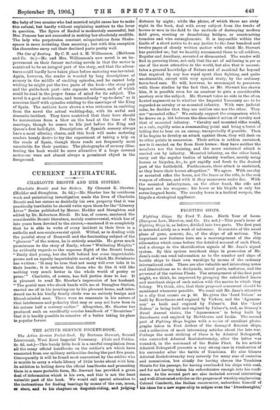FIGHTING SHIPS.
Fighting Ships. By Fred T. Jane. Ninth Year of Issue. (Sampson Low, Marston, and Co. 21s. net.)—This year's issue of Fighting Ships is, as before, divided into two parts. The first part is intended solely as a work of reference. It consists of the usual plans of guns, armour, &c., of the ships of all nations. The important new features here are a rearrangement of the ship silhouettes which come before the detailed account of each Fleet, and a change in the identification signals of Mr. Jane's signal system. By this system merchant ships in possession of Mr. Jane's code can sand information as to the number and class of hostile ships to their own warships by means of the ordinary international code. There are also valuable and interesting notes and illustrations as to dockyards, naval ports, uniforms, and the personnel of the various Fleets. The arrangement of the first part might, we think, be improved by grouping the subsidised liners and merchant ships of each nation with the navies to which they belong. We think, also, that their proposed armament should be mentioned whenever possible. We must call Mr. Jane's attention to a slip that occurs on p. 43. He gives the 'Lord Nelson' as built by Beardmore and engined by Vickers, and the 'Agamem- non' as built and engined by Palmer's. But the 'Lord Nelson' is being built and engined by Palmer's, and, as Braasey's Naval Annual states, the ' Agamemnon ' is being built by Beardmore and engined by Hawthorne and Leslie. The second part of Fighting Ships begins with a series of excellent photo- graphs taken in Port Arthur of the damaged Russian ships, and a collection of most interesting articles about the late war. Perhaps the most striking of these is by Admiral Nebogatoff, who succeeded Admiral Itozhdestvensky, after the latter was wounded, in the command of the Baltic: Fleet. In his article Admiral Nebogatoff presents a very strong case in vindication of his surrender after the battle of Tsushima. He also blames Admiral Rozhelesteensky very severely for many sins of omission and commission, but chiefly for having chosen the Tsushima Straits for his passage, for having overloaded his ships with coal, and for not having taken his subordinates enough into his confi- dence. In the second part are also included several interesting and well-illustrated articles on the progress of warship engineering. Colonel Caniberti, the Italian constructor, unburdens himself of his ideas fox a new super-ship to eclipse even the Dreadnoughts,' but neglects to say anything about the cost of enlarging nearly all the naval docks in the Empire to accommodate battleships of twenty-five thousand tons. Mr. Jane renders a great service to the Navy by the publication of so valuable a book of reference, though be unfortunately renders just as great a service to other navies besides our own. We wish that Mr. Jane could devise a better shape for his book instead of its present extremely ungainly one.— We may take this opportunity for noticing the German naval publication, Mentions (Mittler land Sohn, Berlin), now in its eighth year of issue. This is much less a work of reference than Fighting Ships. In truth, it is a marine review. It has, however, much of interest in it to the student of naval affairs. It contains, more- over, several extremely good photographs of ships of all nations, and includes also a plan of the Dreadnought,' in which the arrangement of the guns is stated correctly. The masts, however, are incorrectly given as of the conventional military pattern, and are put in the wrong place. An important feature of Nauticus is a cable map of the world, which is interesting as showing what a very large proportion of the world's cables are in British hands. Much paper and ink would be spared in German technical books if German technical terms were a little shorter. " Waterboilkettle " is a long way round to go in order to speak of a marine boiler. But notwithstanding this drawback, Nauticus is an important and well-informed publication.











































 Previous page
Previous page